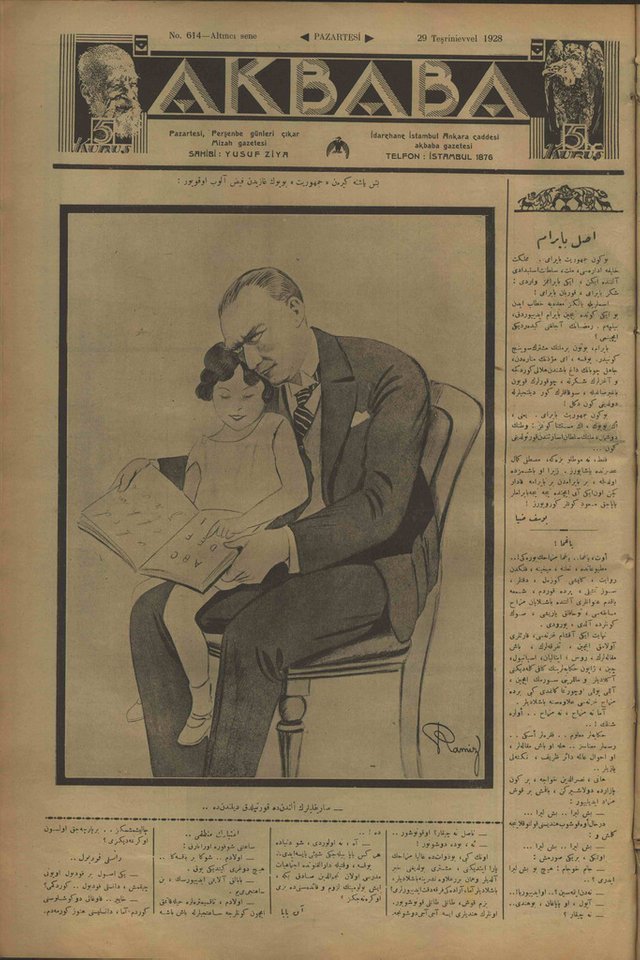29. Today in 1920s Turkey: 29 October 1928 (Happy Republic Day, Turkey!)

(Republic Day Edition Cover Page, Akbaba, 29 October 1928, no. 614, page 1.)
Comments:
Eighty-eight years ago today Turkey celebrated its fifth birthday. On 29 October 1923 the new Turkish state was declared a Republic and since that moment the new administration moved full speed ahead to reform the country and the people. The large cartoon on the front page of this issue of Akbaba simultaneously celebrates the most recent of these changes, alphabet reform alongside Republic Day. Since late summer of 1928 plans for changing the entire country’s official alphabet from the Arabic letters to Latin letters were underway. The date of December 1, 1928 was set for the complete transitioning of the letters. After that date all periodicals were expected to use the Latin letters and public schools were opened across the country with the express goal of teaching the alphabet to everyone, young and old. In the days leading up to December 1 many newspapers and journals began publishing using a mixture of Latin and Arabic letters to help ease their readers into the new alphabet. Examples of such efforts to introduce the new alphabet have been discussed in several past posts (see #16: Famous Person Charles Dickens, #20: Disseminating Knowledge of the New Alphabet, and #21: The War on Ignorance). It is possible to detect some of the changes Akbaba is making toward adopting the new letters. For instance, the masthead on the cover now spells the name of the journal in Latin letters. An example of one of Akbaba’s old masthead designs that used Arabic letters can be seen in post #11.

(Masthead, Akbaba, 29 October 1928, no. 614, page 1.)
The Akbaba title is flanked on either end by small pictures: a vulture on the right and the head of a jovial old man on the left. These two figures represent the two meanings of the word akbaba, i.e., “white-bearded old man” and “vulture.” The cartoonist himself even changes his signature to Latin letters. The artist Ramiz’s new signature can be located in the lower right corner of the picture. It is possible to view Ramiz’s old signature in Arabic through examples of his work discussed in previous posts (see #2, #5, and #11).
The imagery of the cartoon consists of a seated man with a child on his lap. The two people are immersed in an instructional book about the alphabet. The man holding the child and referred to in the text as “Gazi,” is the first president and national hero, Gazi Mustafa Kemal Pasha. After organizing and leading the War of Independence (1919-1922) and ascending to the head of the state Mustafa Kemal Pasha spearheaded the reform efforts of the new administration. His leadership role in national defense and nation-building is often acknowledged and reinforced in cartoons and newspaper articles throughout the 1920s. He took on an additional persona as “national teacher” when he traveled across the country promoting the new letters in autumn, 1928. Emphasizing his roles as “founding father” and “head teacher” to the nation, the artist depicts the Gazi as a paternal pedagogue to the young Republic, represented as a child. For a more in-depth discussion of these national familial roles (where I also discuss this cartoon) see my peer-reviewed article, “We Are Family: The Child and Modern Nationhood in Early Turkish Republican Cartoons (1923-28).” I also discuss this image and related topics as a guest on Episode 102 of the Ottoman History Podcast entitled Child and Nation in Early Republican Turkey.
English:
Above: The Republic who has just turned five is learning to read from the great Gazi.
Below: We are saved from the hands and language of the turbaned ones.
Türkçe:
Üstte: Beş yaşına giren “Cumhuriyet” büyük Gazi’den feyz alıp okuyor:
Altta: Sarıklıların elinden de kurtulduk dilinden de…